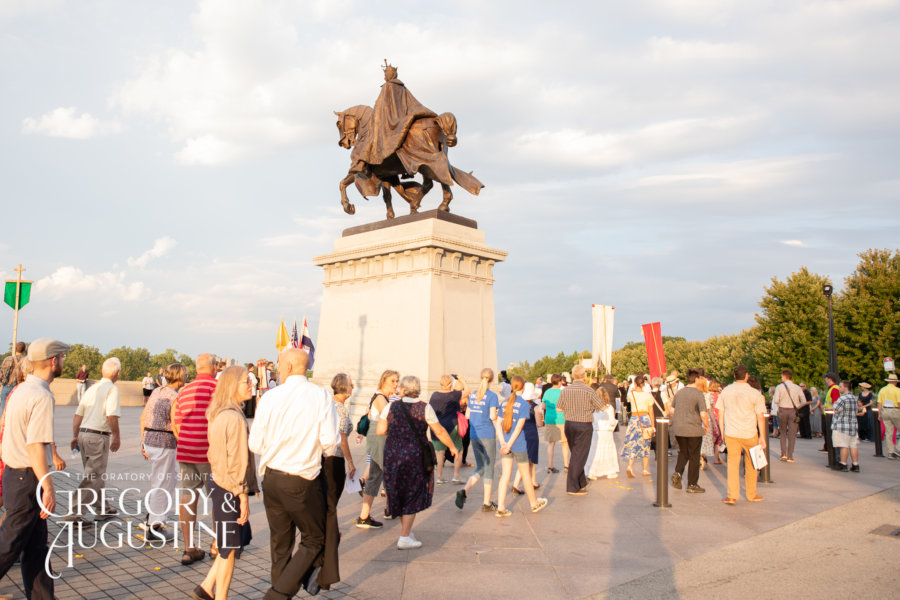A Moment of Christendom: the St. Louis Patronal Procession
Above: Patronal Festivity in Saint Louis, Missouri, 2022 On August 25th, my alarm clock rang at 3:45 a.m. The previous evening, we chant enthusiasts had parted with the words, “Tenebrae et Matutinum” (dark and early). With solemn vespers, we had […]
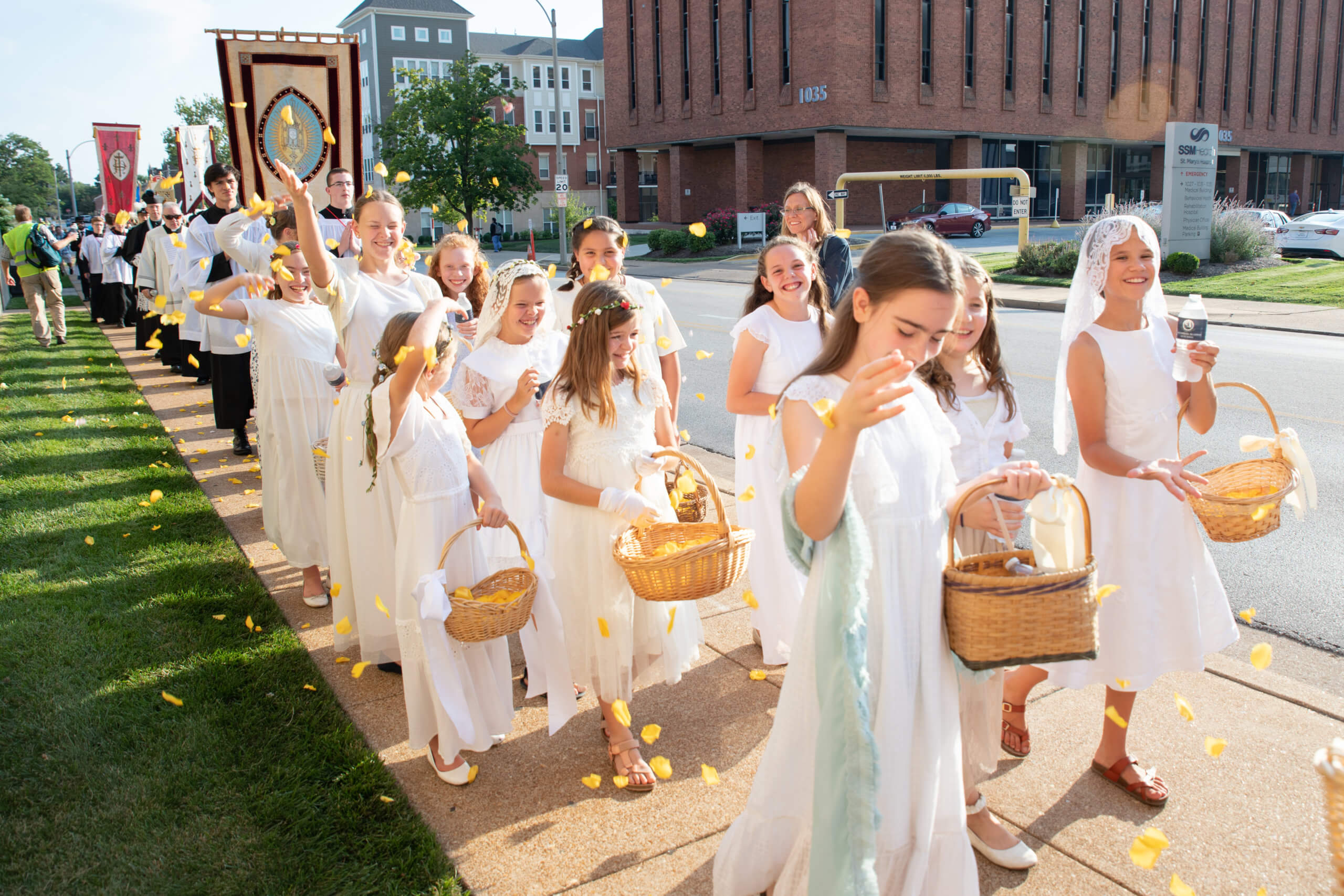
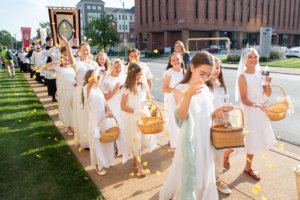
Above: Patronal Festivity in Saint Louis, Missouri, 2022
On August 25th, my alarm clock rang at 3:45 a.m. The previous evening, we chant enthusiasts had parted with the words, “Tenebrae et Matutinum” (dark and early). With solemn vespers, we had ushered in the third annual Festival of Saint Louis, a liturgical whirlwind in honor of our city’s patron saint. Now, before the sun had risen, we would chant matins.
Sleepily gathering my chapel veil and responsories, I passed through my kitchen, which looked like a ransacked florist’s shop. Instead of going to bed early the night before, my sister and I had hosted a flower crown party. We and our girlfriends—“Maidens of St. Louis” we like to call ourselves—had crowded around buckets of roses and carnations to fashion for ourselves fresh crowns to wear for the feast. I smiled as I recalled the shrieks of delight that had sounded whenever my sister, with a modern twist on our medieval revelry, had blown an airhorn to celebrate the completion of each new crown. But at this hour, our crowns rested in refrigerators, to be debuted later on when we would feel (hopefully) a little more lively.
Few souls brave matins of St. Louis’s Day, held at 5 a.m. at the Oratory of Ss. Gregory and Augustine. But meagre attendance never matters to those of us who chant. Or rather, it only matters in so far as it gives us a sense of deep wonder that we, unworthy as we are, have for some reason received the honorable task of praying the ancient prayers on behalf of the entire city. And I admit, one or two of us might also think of another king and “wish not one man more!” We always sing from the office of St. Louis dating back to 1273, so all nine lessons and responsories pertain directly to St. Louis. No generic confessor matins for us!
The later morning boasted solemn Masses held at both Ss. Gregory and Augustine and St. Francis de Sales (the city’s other T.L.M. oratory), and the stalwart men’s schola of the former continued publicly chanting the various hours of the Divine Office.
Though the feast day’s afternoon seemed to present a lull in the action, it was more like a breathless silence before a collective exclamation of joy—that exclamation being a solemn (and very jubilant) two-mile procession to the bronze apotheosis of St. Louis in Forest Park. Each year, we pull out all the stops: a first class relic of St. Louis, a statue of Our lady, clergy, a men’s schola, a women’s schola, Knights of St. John, flower girls, antique banners, flags, and many faithful, bearing small hymn books to sing along.
As a member of the Ss. Gregory and Augustine Altar and Rosary Society, and a self-dubbed “Militant Church Mouse,” I resisted the siesta’s siren call and attended to last minute duties. First, I printed out extra copies of the procession order chart. This, I had helped finalize in a meeting with the schola director, the master of ceremonies, the sacristan, and an altar boy. At twenty-nine years old, I was easily the oldest member present; but anyone familiar with tradition-loving parishes won’t find this very surprising.
Then I ran down to the parish hall to check on the palanquin—a beautiful locally crafted piece, custom-made to bear the relic. I had decorated it the day before with lilies (for France, of course), peacock feathers (signifying royalty), roses, Queen Anne’s lace, and, my secret ingredient, fresh herbs from my mother’s kitchen garden. While doing some liturgical arts research a while back, I read that medieval people would use herbs and wild flowers in their arrangements, so I always surround the relic with these to make King Louis feel at home. I wish I could describe to you the fragrance of lilies blended with basil, rosemary, and sage! Though I hated to add any more weight to the relic-bearers’ shoulders, I poured a little water on the flowers. Lilies are always thirsty, and the day was warm.
Next, I was off to the refrigerator packed chock-full of rose petals. Every year a donor orders eight hundred yellow roses which come packed in boxes straight from Ecuador. We ladies of the Altar and Rosary Society depetal them one by one as we laugh and chat, the sunny yellow having its effect on us. Now it was almost go-time for the petals. I began unceremoniously chucking each gallon bag of them into a trash bag to lug up to the vestibule like a veritable St. Nick of rose petals. There, I would fill baskets for the flower girls and put the rest in the resupply wagon. Even twenty hearty little girls can’t carry 24,000 petals all at once.
Just before running up to the vestibule to start shepherding the flower girls and making sure the banner men were set, I had a minute to pop on my flower crown. With this, a white linen dress, and comfortable sandals, I was in full medieval peasant dress.
Up in the church, they were chanting second vespers and would have Eucharistic adoration, but I had to forego these. When I emerged from the hall, I found the oratory campus had become a hive of activity. There was the team of young men who would carry Our Lady, dressed in crisp suits, chatting amongst themselves and pacing a little nervously; there the team of water runners preparing to quench the thirst of five hundred weary faithful; business and medical professionals zipped in straight from work having conquered rush hour just in time; and a steady convoy of the quintessential homeschooler vans filled the parking lot, their occupants—altar boys, flower girls, and others—pouring out like troops from transport vehicles as their intrepid mothers unfolded strollers.
In the vestibule, my sister and I filled the baskets. We worked as quietly as mice lest we disturb those praying in the church. Flower girls had begun to gather around us. Some of them tiny, not yet even communicants, others graceful, older girls already confirmed, all dressed in white or blue. One little girl even had white gloves.
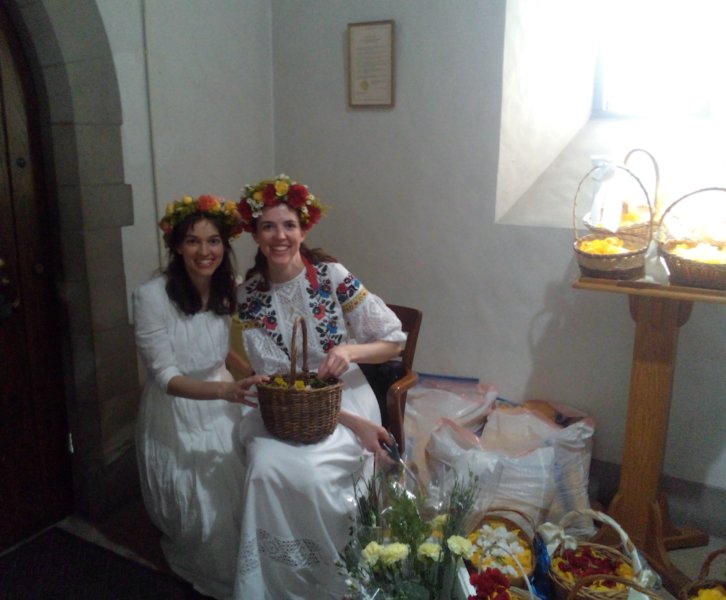
Banners, lovingly restored by the good seamstresses of the Altar and Rosary Society, were staged all around us. As each new gentleman showed up to claim his banner, I gave a brief tutorial on the best way to carry the great billowing things.
My sister had brought the left-over carnations from our flower crown party, and she started handing them out to passing men for their button holes. The men to carry Our Lady kept coming back with requests for red ones, and we took to calling them the “Red Carnation Boys.” Later on, I would smile as I saw them valiantly carrying that heavy Marian palanquin, its un-cushioned rods crushing down on their shoulders and making pulp of their carnations. How Our Lady must have smiled too!
Bells began to ring. The schola sang the Tantum Ergo. Now the crucial moment approached when I would add my flower girls into the procession as it came with the relic straight down the nave. The girls, eager to see the happenings inside the church pressed forward, but I gently called them back lest they obstruct the head of the procession. They were all so sweet and a little solemn, understanding the gravity of the occasion. I asked them to pair up in ranks of twos. This, they did swiftly, putting their arms around each other. The littlest girl found herself the odd one out and was quickly adopted by two older ones. Someone opened the doors (no one ever thinks to plan the opening of the doors; it just happens). A choir had already assembled outside; they sang the Morales Alleluia.
I kept peeking into the nave to mark the progress of the assembling procession. Of course, the relic was what slowed them down. At last, they came, and now at no slow pace, the crucifix with the acolytes, the flags, the little altar boys with tiny banners their size; that was my cue. I reached out an arm and said, “first two girls.” For a moment they looked at me like deer in headlights and then they went, two by two, tripping along giddily, their long wait come to an end. I stood there a moment watching as more altar boys, clergy from several parishes, knights, more flags, and the relic itself carried by the oldest, strongest altar boys, flashed by—a stream of cassocks, lace, ostrich plumes, fluttering colors, and gold. I beamed with joy and then remembered I had to run and join the women’s schola which would position itself towards the middle of the procession to lead the faithful who were too far back to hear the men’s schola in the front.
It was a glorious evening—warm with a lavender and peach tinted sky. A normal August evening for most, but far from normal for us! The other maidens of St. Louis had shown up in their white dresses and flower crowns. We sang the Litany of Saints, Immaculate Mary, Hail Holy Queen, and, just as police had stopped traffic four ways on busy Skinker Boulevard, we sang Oh God Beyond All Praising in the middle of the intersection. Though I was too far back to hear or see the flower girls (I only saw the steady stream of petals they left in their wake), someone later told me they had sung from memory Faith of Our Fathers with the men’s schola, and it had melted the clergy’s hearts.
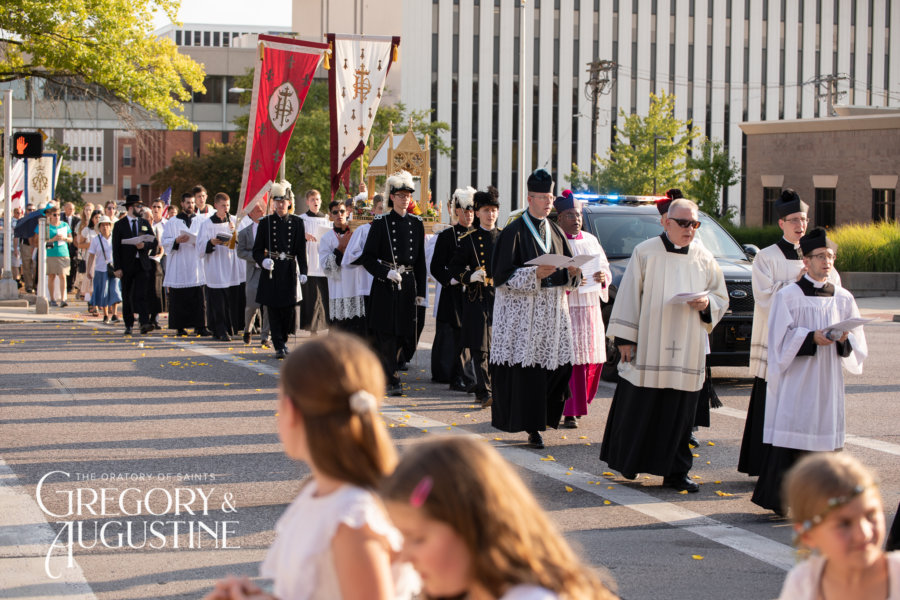
The procession entered the edge of Forest Park, and soon caught sight of the statue of Saint Louis, standing in all its glory on Art Hill. It is the statue that the miscreants of Cancel Culture have yet to topple, and it is the procession’s cue to begin the Christus Vincit.
We gathered around the statue’s pedestal and prayed the Rosary in the presence of the relic, a large crucifix, and the statue of Our Lady. Then we celebrated with three hundred cups of ice cream that disappeared in a flash. No multiplication miracle this year. A pop-up shower curtailed outdoor celebrations, but everyone assisted in cleaning up and shuttling the various accoutrements back to the oratory.
I ended the day at a house party where we sang Le Roi Louis while I beat a tambourine like a wild medieval peasant. (I suppose there is a place in God’s good kingdom for tambourines.)
Here’s to next year.
Pilgrims from every corner of Christendom are always welcome!
Special thanks to Mrs. Kiera Petrick for the photos.
